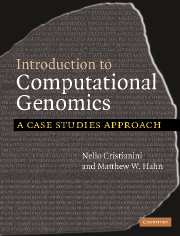Book contents
- Frontmatter
- Contents
- Preface
- Prologue: In praise of cells
- Chapter 1 The first look at a genome
- Chapter 2 All the sequence's men
- Chapter 3 All in the family
- Chapter 4 The boulevard of broken genes
- Chapter 5 Are Neanderthals among us?
- Chapter 6 Fighting HIV
- Chapter 7 SARS – a post-genomic epidemic
- Chapter 8 Welcome to the hotel Chlamydia
- Chapter 9 The genomics of wine-making
- Chapter 10 A bed-time story
- Bibliography
- Index
Chapter 1 - The first look at a genome
Sequence statistics
Published online by Cambridge University Press: 05 June 2012
- Frontmatter
- Contents
- Preface
- Prologue: In praise of cells
- Chapter 1 The first look at a genome
- Chapter 2 All the sequence's men
- Chapter 3 All in the family
- Chapter 4 The boulevard of broken genes
- Chapter 5 Are Neanderthals among us?
- Chapter 6 Fighting HIV
- Chapter 7 SARS – a post-genomic epidemic
- Chapter 8 Welcome to the hotel Chlamydia
- Chapter 9 The genomics of wine-making
- Chapter 10 A bed-time story
- Bibliography
- Index
Summary
Genomic era, year zero
In 1995 a group of scientists led by Craig Venter, at The Institute for Genomic Research (TIGR) in Maryland, published a landmark paper in the journal Science. This paper reported the complete DNA sequence (the genome) of a free-living organism, the bacterium Haemophilus influenzae (or H. influenzae, for short). Up until that moment, only small viral genomes or small parts of other genomes had been sequenced. The first viral genome sequence (that of phage phiX174) was produced by Fred Sanger's group in 1978, followed a few years later by the sequence of human mitochondrial DNA by the same group. Sanger – working in Cambridge, UK – was awarded two Nobel prizes, the first one in 1958 for developing protein sequencing techniques and the second one in 1980 for developing DNA sequencing techniques. A bacterial sequence, however, is enormously larger than a viral one, making the H. influenzae paper a true milestone. Given the order of magnitude increase in genome size that was sequenced by the group at TIGR, the genomic era can be said to have started in 1995.
Genomes and genomic sequences
Probabilistic models of sequences
Statistical properties of sequences
Standard data formats and databases
A few months later the same group at TIGR published an analysis of the full genome of another bacterium, Mycoplasma genitalium – a microbe responsible for urethritis – and shortly thereafter the sequence of the first eukaryote, the fungus, Saccharomyces cerevisiae (or S. cerevisiae, baker's yeast) was published by other groups.
- Type
- Chapter
- Information
- Introduction to Computational GenomicsA Case Studies Approach, pp. 1 - 21Publisher: Cambridge University PressPrint publication year: 2006



